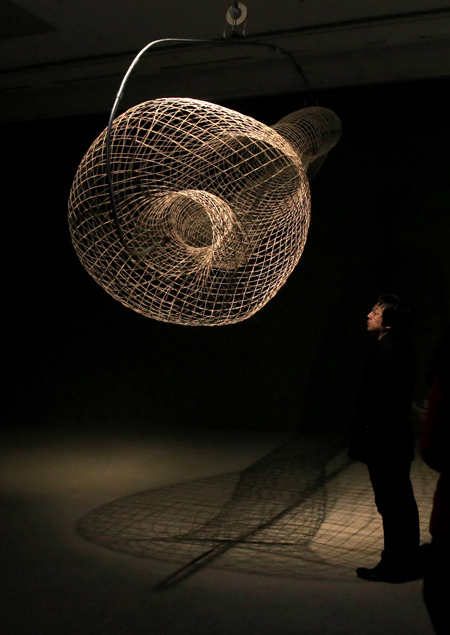
A visitor stops at Gimbaled Klein Basket by American artist Tim Hawkinson at the ongoing exhibition. Jiang Dong / China Daily
Two ongoing exhibitions at the National Art Museum of China look at art history from the perspective of looking back, and looking forward.
One presents nearly 79 sculptures and drawings to show the evolution of Spanish sculpture in the 20th century; the other provides interactive experiences with new media artworks mostly created since 2005.
Conquest of Three Dimensions: From Picasso to Barcelo traces the renewal of Spanish sculpture after it took an aesthetic departure from the first avant-garde movement.
It encompasses many of the main styles and genres of the past 100 years, beginning with the modernist ideas of Antoni Gaudi, up till Miquel Barcelo.
Viewers will need to disassociate from conventional ideas of sculpture - the human body presented in a realistic manner - if they want to understand more about the works on show. The sculptors appear to no longer favor powerful or heavy masses and volumes, but consider space an equally or even more important element of a work.
Featured artists include such radical ones as Pablo Gargallo, Julio Gonzales and Picasso, who were vital to the development of iron sculptures in the 1920s and 30s, and whose artistic ventures enriched organic and abstract sculpture.
Apart from the works by surrealist representatives Salvador Dali and Joan Miro, the exhibition also introduces artists who kept alive the flame of the avant-garde during the Spanish civil war and re-linked Spanish art with international trends after the 1950s.
Finally, the exhibition presents significant yet unorthodox voices, including constructive, expressionist and conceptual genres, which the Spanish art witnessed from the 1980s.
Each sculpture is accompanied by one or two drawings by the same artist, which complements viewers' knowledge of their techniques. The juxtaposition provides a glimpse of how artists transformed an idea into a three-dimensional subject.
"A generation of great artists, Picasso being the main exponent, explored modern artistic languages via experimental and innovative approaches, which formed the rich variety of Spanish art," says Fan Di'an, director of the National Art Museum of China. "From the abstract to the concrete, the exhibition gives viewers an insight into these artists' relationship with the culture of their day."

Copyright ©1999-2011 Chinanews.com. All rights reserved.
Reproduction in whole or in part without permission is prohibited.